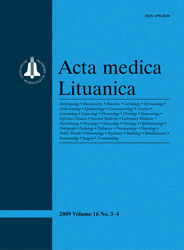 ISSN 1392-0138 ISSN 2029-4174 (online) |
2008 m. Nr. 4 Athletes’ anthropometrical measurements and physical capacity influence on learning competitive swimming techniques
The aim of our study was to look at the relationship of the anthropometrics and exercise capacity to the ability to acquire swimming skills in freestyle (front crawl), backstroke, and breaststroke. Research methods and organization. Eighteen 17–18 aged male athletes from various (not directly related with swimming) sports volunteered to participate in the study, namely, standard swimming learning program, which consisted of 40 sessions from 60 to 70 minutes in duration with the frequency of three times per week. Anthropometrical measurements, exercise capacity tests (Eurofit tests), and analysis of swimming abilities were all performed before the initiation of the swimming learning program, and the swimming abilities were re-tested after the successful completion of the learning process. Results. The results of the study showed the majority of young male athletes engaged in “terrestrial” sports being well physically developed to be poor swimmers. Nevertheless, they are able to successfully acquire skills of competitive swimming strokes during the well-organized learning process of 40 learning sessions. The degree of the improvement in all the strokes taught is related to body height, skinfold thickness, as well as circumferences of body segments, the former correlating to the post-program swimming abilities positively, and the latter negatively. Conclusion. Consequently, taller, fatter (and thus more buoyant) young individuals with smaller body-segment girths seem to favour from their somatotype in the process of learning to swim freestyle, backstroke, and breaststroke. Keywords: swimming, motor-learning, anthropometrics |
Issues:
2011 - Vol.18 No. 1, No. 2, No. 3, No. 4 2010 - Vol.17 No. 1-2, No. 3-4 2009 - Vol.16 No. 1-2, No. 3-4 2008 - Vol.15 No. 1, No. 2, No. 3, No. 4 2007 - Vol.14 No. 1, No. 2, No. 3, No. 4 2006 - Vol.13 No. 1, No. 2, No. 3, No. 4 2005 - Vol.12 No. 1, No. 2, No. 3, No. 4 2004 - Vol.11 No. 1, No. 2, No. 3, No. 4 2003 - Vol.10 No. 1, No. 2, No. 3, No. 4 2002 - Vol.9 No. 1, No. 2, No. 3, No. 4 2001 - Vol.8 No. 1, No. 2, No. 3, No. 4 |